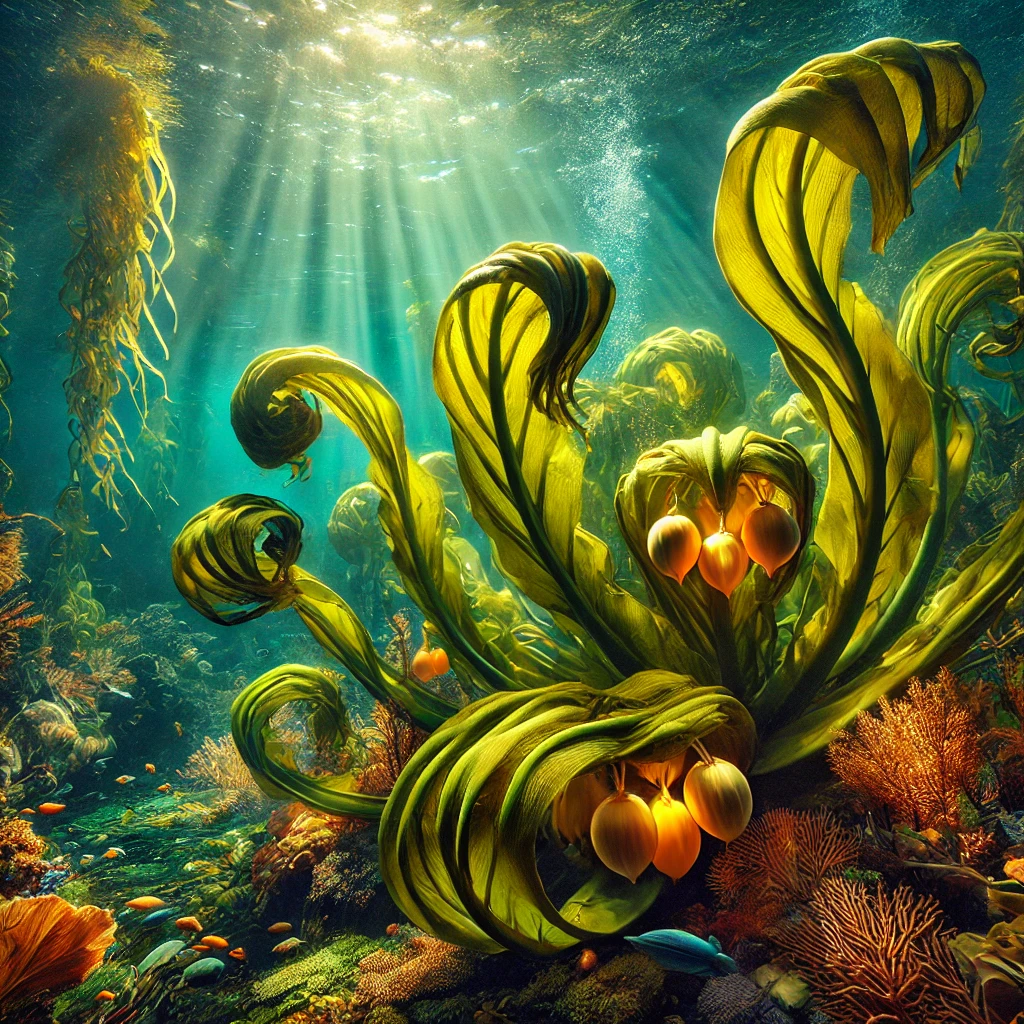Kelpheart Vines
The Kelpheart Vines are a remarkable aquatic flora native to the western coasts of the Kirdes Deep in Trura. These underwater plants play a vital role in the marine ecosystems of the region, providing sustenance, shelter, and ecological balance while offering a variety of uses for Truran communities. Their unique properties and striking appearance make them a symbol of resilience and harmony in Trura's coastal culture.
Anatomy and Morphology
The Kelpheart Vines are large, fast-growing sea plants with a distinct structure that supports their survival in the dynamic marine environment of the Kirdes Deep.
Roots (Holdfasts)
- Type: Fibrous holdfasts that anchor the vines securely to rocks, reefs, or the ocean floor.
- Function: Stabilize the plant against strong underwater currents while allowing nutrient absorption from the surrounding water and seabed.
Stems
- Structure: Long, flexible stems known as stipes, which can grow up to 20 feet in length, depending on water depth and nutrient availability.
- Strength: Resilient yet pliable, capable of withstanding turbulent waves and shifting tides.
Leaves (Fronds)
- Appearance: Broad, ribbon-like fronds with a deep emerald green color, often with iridescent undertones that shimmer in sunlight or moonlight.
- Surface: Covered with tiny pores that facilitate gas exchange and nutrient absorption from seawater.
- Adaptation: The fronds are buoyant due to small, gas-filled bladders (pneumatocysts), allowing the plant to float and maximize sunlight exposure for photosynthesis.
Heart Pods
- Appearance: Small, bulbous structures at the base of the fronds, often golden or copper-hued, resembling miniature hearts.
- Function: Store nutrients and energy for the plant, particularly during unfavorable conditions such as storms or prolonged cloud cover.
Growth and Life Cycle
Kelpheart Vines are among the fastest-growing marine plants, capable of growing up to 12 inches per day in optimal conditions. Their life cycle includes several stages:
1. Spore Stage
- The vines reproduce through spores, which are released into the water and settle on suitable surfaces to germinate.
- Spores are coated with a faint magical essence, believed to enhance their resilience against predation and environmental stress.
2. Seedling Stage
- Tiny sprouts emerge from the spores, attaching themselves firmly to the ocean floor using their holdfasts.
- This stage is critical for survival, as the seedlings are vulnerable to currents and marine herbivores.
3. Mature Stage
- The vines rapidly grow their stipes and fronds, forming dense underwater forests that serve as habitats for various marine species.
- At full maturity, the vines produce their distinctive heart pods, signaling the peak of their life cycle.
4. Regenerative Stage
- Even after being partially damaged by storms or harvesting, the vines regenerate rapidly, making them a sustainable resource.
Ecological Role
The Kelpheart Vines are foundational to the coastal ecosystems of Trura, providing a wide range of ecological benefits:
- Habitat Creation: The dense fronds form underwater forests that shelter fish, crustaceans, and other marine organisms, fostering biodiversity.
- Erosion Control: The holdfasts stabilize the seabed and prevent erosion caused by waves and currents.
- Carbon Sequestration: The vines absorb significant amounts of carbon dioxide from seawater, helping to regulate the local marine environment and mitigate climate effects.
- Nutrient Cycling: Decaying fronds enrich the surrounding waters and seabed, supporting other marine life.
Cultural and Practical Uses
The Kelpheart Vines are an essential resource for Trura’s coastal communities, used in numerous ways:
Food
- Edible Fronds: The fronds are rich in vitamins, minerals, and protein, commonly harvested, dried, and consumed as a nutrient-packed food source.
- Heart Pods: The pods are a delicacy, often pickled or added to soups for their unique flavor and health benefits.
- Kelp Wine: Coastal brewers ferment the vines to create a distinctive, slightly briny wine prized for its taste and restorative properties.
Medicine
- Nutrient-Rich Extracts: Kelpheart Vines are used in tonics and supplements to boost vitality and improve immune health.
- Healing Gels: The fronds' gel-like sap is applied to wounds and burns as a soothing, antimicrobial treatment.
Crafting and Industry
- Textiles: The fibers from the vines are processed into durable threads and ropes, used for fishing nets, clothing, and maritime equipment.
- Fertilizer: Dried and ground vines enrich soil, making them valuable in coastal agriculture.
- Bioluminescent Decorations: When dried, parts of the vines retain their faint shimmer, used in decorative crafts and jewelry.
Magic and Rituals
- Spell Components: The vines are often used in water-based spells and enchantments, especially those involving restoration and protection.
- Sacred Offerings: In Gidianist rituals, the vines symbolize resilience and abundance, often presented as offerings to honor the divine essence of Gidia.
Conservation and Sustainability
Recognizing the ecological and cultural importance of Kelpheart Vines, Trura has implemented strict conservation measures:
- Sustainable Harvesting: Regulations ensure that vines are harvested responsibly, preserving their role in marine ecosystems.
- Protected Zones: Parts of the Kirdes Deep are designated as marine sanctuaries where harvesting is prohibited.
- Community Stewardship: Coastal communities are actively involved in replanting and monitoring kelp forests, maintaining their vitality for future generations.
The Kelpheart Vines exemplify Trura’s harmonious relationship with its natural environment. They are not only a lifeline for coastal ecosystems but also a cherished resource that enriches the lives of Trura’s people through food, medicine, culture, and magic. Their resilience and versatility make them a symbol of the enduring balance between nature and human ingenuity.



Comments